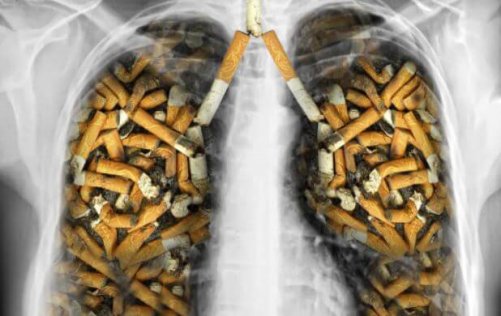The Negative Effects of Tobacco for Athletes

Tobacco addiction is one of the most harmful habits in today’s society. It’s such a problem that many governments consider it to be a public health issue. Tobacco is directly responsible for some five million deaths per year. Many people who smoke try to perform physical activity in order to reduce the negative effects of this habit. However, tobacco for athletes is especially undesirable.
Evaluating the negative effects of tobacco on athletes
For decades, people have discussed the negative effects of tobacco addiction. We say “discussed” because there are studies of dubious origin, that speak about the supposed benefits of tobacco and its prime ingredient: nicotine.
Also read: Discover 10 Benefits of Exercise
But beyond extreme publicity gimmicks of questionable morality, everyone knows that smoking is bad. So, what are the negative effects of smoking tobacco? Smoking harms the whole cardiovascular system and limits lung capacity. Not only that, but there’s also a long list of other effects, this includes damage to the urinary system.
Second-hand smokers: affected but silent
Tobacco not only impacts smokers it also has negative effects on those people who live with smokers. Statistics show us that the smoker inhales 15 percent of the smoke, and the remaining 85 percent is released into the air.
The most vulnerable group of people exposed to second-hand tobacco smoke are children. Studies have linked tobacco to cases of ear inflammation, asthma, and other respiratory disorders. There is a high probability that these children will eventually become smokers themselves.
Children in the highest risk group are referred to by experts as “hereditary smokers.” These are the babies conceived by smokers. The most severe cases are babies born to mothers who are addicted to nicotine during the pregnancy or the lactation period.
Tobacco for athletes: a dangerous combination
Smoking offers no positive effects on health. It also minimizes the positive effects of regular physical activity on the body. Playing sports doesn’t counteract the harm caused by this habit.

Mixing cigarettes and exercise can carry more risks than smoking while maintaining a sedentary lifestyle. A smoker’s heart must work even harder to fulfill the demands placed on it.
The number of beats per minute at rest is higher among smokers. This makes normal breathing difficult after an intense bout of activity.
The lungs: one of the biggest losers in tobacco for athletes
Cigarettes are the primary cause of lung cancer. And that’s without mentioning the fact that smoking directly affects all of the other organs involved with the respiratory tract, from the mouth to the bronchi.
When you dramatically limit the capacity of the lungs, the amount of oxygen that reaches the blood is substantially lowered. This situation leads to oxygen deficiency in the body’s tissue, which can cause a high risk of muscular system fatigue and even subsequent collapse.
Compromised muscles
The negative impact of cigarettes on the muscles goes further than simply causing you to rapidly tire or delaying the recuperative processes. It stunts muscular growth, making your weight-lifting sessions in the gym virtually fruitless.
At the same time, smoking can cause a reduction in the size of the muscle tissue and its ability to exert force. Among other reasons, this happens because the amount of glycogen phosphorylase increases. This enzyme breaks glucose down, and glucose is responsible for the energy reserves in the muscles.

Tobacco for athletes: how to overcome this addiction?
Nicotine has stimulant and anti-depressive effects. Many experts believe that these characteristics are one of the leading causes of tobacco’s addictive power. This addiction is the second strongest after that of heroin.
Another argument that smokers tend to make in support of their habit, is that it helps to control anxiety levels. Does tobacco really help you to fight daily stress? Let’s not forget that physical exercise is one of the best ways to alleviate stress.
Experts recommend that smokers (especially long-term smokers) start exercising slowly and carefully. It’s necessary to adapt the body to progressive physical activity. After recovery from your addiction, you should realize that the negative effects on the lungs, from years of smoking, can’t simply be reversed in just a couple of days.
Tobacco addiction is one of the most harmful habits in today’s society. It’s such a problem that many governments consider it to be a public health issue. Tobacco is directly responsible for some five million deaths per year. Many people who smoke try to perform physical activity in order to reduce the negative effects of this habit. However, tobacco for athletes is especially undesirable.
Evaluating the negative effects of tobacco on athletes
For decades, people have discussed the negative effects of tobacco addiction. We say “discussed” because there are studies of dubious origin, that speak about the supposed benefits of tobacco and its prime ingredient: nicotine.
Also read: Discover 10 Benefits of Exercise
But beyond extreme publicity gimmicks of questionable morality, everyone knows that smoking is bad. So, what are the negative effects of smoking tobacco? Smoking harms the whole cardiovascular system and limits lung capacity. Not only that, but there’s also a long list of other effects, this includes damage to the urinary system.
Second-hand smokers: affected but silent
Tobacco not only impacts smokers it also has negative effects on those people who live with smokers. Statistics show us that the smoker inhales 15 percent of the smoke, and the remaining 85 percent is released into the air.
The most vulnerable group of people exposed to second-hand tobacco smoke are children. Studies have linked tobacco to cases of ear inflammation, asthma, and other respiratory disorders. There is a high probability that these children will eventually become smokers themselves.
Children in the highest risk group are referred to by experts as “hereditary smokers.” These are the babies conceived by smokers. The most severe cases are babies born to mothers who are addicted to nicotine during the pregnancy or the lactation period.
Tobacco for athletes: a dangerous combination
Smoking offers no positive effects on health. It also minimizes the positive effects of regular physical activity on the body. Playing sports doesn’t counteract the harm caused by this habit.

Mixing cigarettes and exercise can carry more risks than smoking while maintaining a sedentary lifestyle. A smoker’s heart must work even harder to fulfill the demands placed on it.
The number of beats per minute at rest is higher among smokers. This makes normal breathing difficult after an intense bout of activity.
The lungs: one of the biggest losers in tobacco for athletes
Cigarettes are the primary cause of lung cancer. And that’s without mentioning the fact that smoking directly affects all of the other organs involved with the respiratory tract, from the mouth to the bronchi.
When you dramatically limit the capacity of the lungs, the amount of oxygen that reaches the blood is substantially lowered. This situation leads to oxygen deficiency in the body’s tissue, which can cause a high risk of muscular system fatigue and even subsequent collapse.
Compromised muscles
The negative impact of cigarettes on the muscles goes further than simply causing you to rapidly tire or delaying the recuperative processes. It stunts muscular growth, making your weight-lifting sessions in the gym virtually fruitless.
At the same time, smoking can cause a reduction in the size of the muscle tissue and its ability to exert force. Among other reasons, this happens because the amount of glycogen phosphorylase increases. This enzyme breaks glucose down, and glucose is responsible for the energy reserves in the muscles.

Tobacco for athletes: how to overcome this addiction?
Nicotine has stimulant and anti-depressive effects. Many experts believe that these characteristics are one of the leading causes of tobacco’s addictive power. This addiction is the second strongest after that of heroin.
Another argument that smokers tend to make in support of their habit, is that it helps to control anxiety levels. Does tobacco really help you to fight daily stress? Let’s not forget that physical exercise is one of the best ways to alleviate stress.
Experts recommend that smokers (especially long-term smokers) start exercising slowly and carefully. It’s necessary to adapt the body to progressive physical activity. After recovery from your addiction, you should realize that the negative effects on the lungs, from years of smoking, can’t simply be reversed in just a couple of days.
This text is provided for informational purposes only and does not replace consultation with a professional. If in doubt, consult your specialist.








